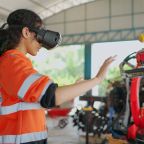Augmented reality (AR) plane detection, also known as AR plane object breakaway, lets learners place a 3D model of any object onto a tabletop or floor surface in front of them. Once placed, learners can complete any of the following actions:
- Rotate and resize the object
- Walk around the object
- View internal components of the object
- Get detailed information — or even find step-by-step instructions — on how to repair or install the object
Plane detection is one of three AR training technologies that develops learners’ hard skills through interactive learning activities.
Ready to learn more about plane detection? Let’s dive into what augmented reality (AR) plane detection is and examples of its use for training.
What Is Plane Detection?
AR plane detection, also known as AR plane object breakaway, lets learners place a 3D model of any object onto a tabletop or floor surface in front of them. Once placed, learners can complete any of the following actions:
- Rotate and resize the object
- Walk around the object
- View internal components of the object
- Get detailed information — or even find step-by-step instructions — on how to repair or install the object
By simply pointing their device at a flat surface in front of them, learners can place a full-scale model of a large machine or object. One of three AR technologies, plane detection allows learners to walk around, inspect, and practice operating on and repairing objects without risk.
Benefits Of Augmented Reality Plane Detection
- Places a full-scale 3D model — The major advantage of AR plane detection is that it places a true-to-size digital model in front of learners. The object and its parts are all developed according to scale, which better prepares learners for real-life interactions.
- Learners can isolate and manipulate individual parts — Learners can walk around, inspect, rotate, and practice operating their digital object. In addition to a holistic view of the 3D object, learners can learn about individual pieces of the object by interacting with them, reading key information, and watching videos.
- Access from anywhere — As long as learners have a connection to their learning app and device (e.g. a tablet or mobile device), they can place the digital object in front of them regardless of where they’re located. This allows for more accessible learning that reaches learners at any location.
Read More: How to Develop Augmented Reality Training for Your Company
Examples Of Augmented Reality Plane Detection For Training
Practice Reporting On A Complex Data Center
After placing a large data center in front of them, a learner can walk around the object and examine its parts in detail. While data centers are quite large and complex, this AR activity allows learners to isolate a specific section of the center and focus on the individual task at hand through microlearning.
With the 3D model of the data center, learners can practice identifying, logging, and reporting issues about the system. For additional learning support, this activity provides learners with interactive video tutorials and pop-up pictures that they can learn from.
Complete In-Depth Repairs For A Motor
Once learners anchor a realistic motor on a flat surface in front of them, they can complete any of the following tasks:
- View the object holistically
- Practice running the motor
- View information about each individual part
- Watch a video of the installation of the motor
This activity creates a safe learning environment where learners can practice completing complex tasks that would otherwise risk damaging the equipment in real life.








